Combining Geometry And MeasurementGeometry and measurement activities can be fun to combine in outdoor experiences for practical applications and real life examples. This is another way to take learning outdoors during the warmer weather. Learning How To MeasureFirst, it is important to learn how to measure with standard units of measure. This may be customary units or metric units, depending on what is standard where you live. If you are looking for some anchor charts or guides to help with this check out my measurement category. There are so many different ways to have fun learning to measure items. Here are a few ideas. Are you a rectangle or a square? Is your arm span equal to your height making you a square, or is it shorter or longer making you a rectangle? I love using this activity as a family activity for student led conferences. Who can find the most? Use a measuring tape and try to find as many items as possible that are 10 cm or 4 inches long in the classroom. This can be a group or partner activity. How much does this container hold? Have an assortment of containers of different shapes and see which hold the most liquid. This can be a fun way to guess liquid volumes. Which weighs more? Use a scale and measure different groups of objects to see which are heavier. These could be classroom objects such as books, blocks, or backpacks.
Once they are comfortable with measurement units and how to use them, it will be time to add in another component. Learning about perimeter and area is an important skill and a great tool for taking outdoors for practical applications. Start with practicing how to calculate perimeter and area of objects and show how they got their answers, Use examples on paper and work with graph paper to help distinguish given measurements. After they practice with scaled drawings, it would be fun to try doing larger measurements outside. As an extension, they could also use graph paper and learn how to measure the school yard, the building, the playground, the fenced area, etc. and record it on the graph paper. Geometry In The EnvironmentIt will also be necessary to do some work with geometry activities to prepare for outdoor applications. It is important to be able to recognize 2D shapes and 3D shapes. Once the shapes are identified, then activities can be done to find them in the environment. These can be matching activities, bingo, geometry building activities, and even geometry worksheets. If you are looking for some resources to help with this, check out my geometry category. Once the kids have an understanding of the basics of measurement and geometry, it is time to put it all together and take it outdoors. For most of the measurement situations, linear measurement will probably be used, but it is possible to do some mass or volume as extensions if wanted. You can have some specific geometry and measurement tasks ready, but it might also be fun to have the kids choose some of their own to try. The goal is to help them to see ways to use geometry and measurement skills in the real world, so if they are able to create some of the tasks, this is a great way to see if they have mastered the concepts. Have fun taking math outdoors. I would love to hear about your adventures. Related Posts
0 Comments
Leave a Reply. |
About Me Charlene Sequeira
I am a wife, mother of 4, grandmother of 9, and a retired primary and music teacher. I love working with kids and continue to volunteer at school and teach ukulele. Categories
All
|














 RSS Feed
RSS Feed